POP介绍与使用实践(快速上手动画)

作者:里脊串 授权本站转载。
前言
动画在APP开发过程中 大家多多少少都会接触到 而且随着iOS7的扁平化风格启用之后 越来越多的APP开始尝试加入各种绚丽的动画交互效果以增加APP的用户体验(当然 还是以国外的APP居多)
有过相关开发经验的同学肯定知道在iOS中 动画相关的部分都是基于Core Animation 但是今天我们不讨论Core Animation 今天的主角是POP -来自于Facebook的动画引擎(其实我不喜欢把POP定义为动画引擎 我愿意称它为函数发生器)
介绍
官方地址 https://github.com/facebook/pop
官方介绍(翻译版)
POP是一个在iOS与OS X上通用的极具扩展性的动画引擎 它在基本的静态动画的基础上增加的弹簧动画与衰减动画 使之能创造出更真实更具物理性的交互动画 POP的API可以快速的与现有的ObjC代码集成并可以作用于任意对象的任意属性
POP是个相当成熟且久经考验的框架 Facebook出品的令人惊叹的Paper应用中的所有动画和效果即出自POP
安装方式还是推荐使用 CocoaPod
pod 'pop', '~> 1.0'
POP的神奇之处在于 它是独立与Core Animation的存在 所以 忘记Core Animation吧 忘记Layer Tree吧 迎接一个简单的明天 (LOL 开玩笑的~:) 很多地方还是会需要Core Animation的 不过说不定哪天苹果大发善心 将动画相关的部分向POP借鉴一点也不是不可能的(比如SpriteKit就借鉴了Cocos2D :)
使用
POP默认支持三种动画 但同时也支持自定义动画
-
POPBasicAnimation
-
POPSpringAnimation
-
POPDecayAnimation
-
POPCustomAnimation //自定义动画
这里我们只讨论前三种(因为自定义动画我也没用过 :) 先来看看官方的示例代码吧
官方代码示例
//Basic animations can be used to interpolate values over a specified time period. To use an ease-in ease-out animation to animate a view's alpha from 0.0 to 1.0 over the default duration: POPBasicAnimation *anim = [POPBasicAnimation animationWithPropertyNamed:kPOPViewAlpha]; anim.fromValue = @(0.0); anim.toValue = @(1.0); [view pop_addAnimation:anim forKey:@"fade"]; //Spring animations can be used to give objects a delightful bounce. In this example, we use a spring animation to animate a layer's bounds from its current value to (0, 0, 400, 400): POPSpringAnimation *anim = [POPSpringAnimation animationWithPropertyNamed:kPOPLayerBounds]; anim.toValue = [NSValue valueWithCGRect:CGRectMake(0, 0, 400, 400)]; [layer pop_addAnimation:anim forKey:@"size"]; //Decay animations can be used to gradually slow an object to a halt. In this example, we decay a layer's positionX from it's current value and velocity 1000pts per second: POPDecayAnimation *anim = [POPDecayAnimation animationWithPropertyNamed:kPOPLayerPositionX]; anim.velocity = @(1000.); [layer pop_addAnimation:anim forKey:@"slide"];
POPBasicAnimation
POPBasicAnimation使用最广泛 提供固定时间间隔的动画(如淡入淡出效果)
代码示例1
POPBasicAnimation *anBasic = [POPBasicAnimation animationWithPropertyNamed:kPOPLayerPositionX]; anBasic.toValue = @(self.square.center.y+300); anBasic.beginTime = CACurrentMediaTime() + 1.0f; [self.square pop_addAnimation:anBasic forKey:@"position"];
其动画效果如下
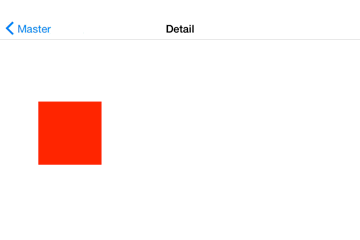
可以看到 添加一个动画最少仅需三步
-
定义一个animation对象 并指定对应的动画属性
-
设置初始值和默认值(初始值可以不指定 会默认从当前值开始)
-
添加到想产生动画的对象上
POPBasicAnimation可配置的属性与默认值为
duration:0.4 //动画间隔
POPBasicAnimation提供四种timingfunction(很熟悉 对不对? 就是Core Animation中那些)
-
kCAMediaTimingFunctionLinear
-
kCAMediaTimingFunctionEaseIn
-
kCAMediaTimingFunctionEaseOut
-
kCAMediaTimingFunctionEaseInEaseOut
其时间函数分别如下
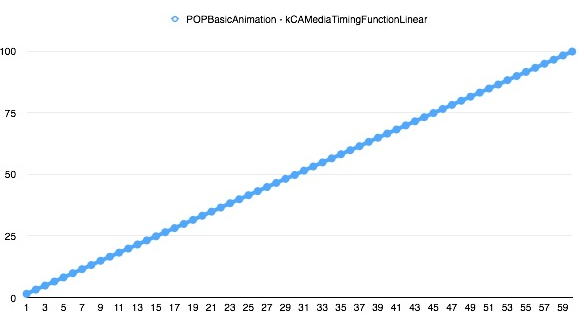
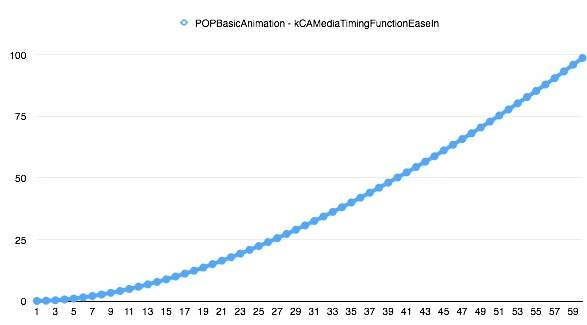
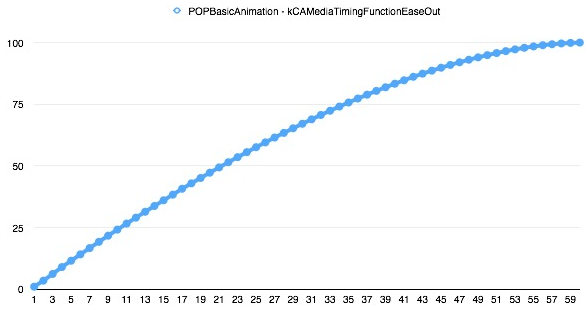
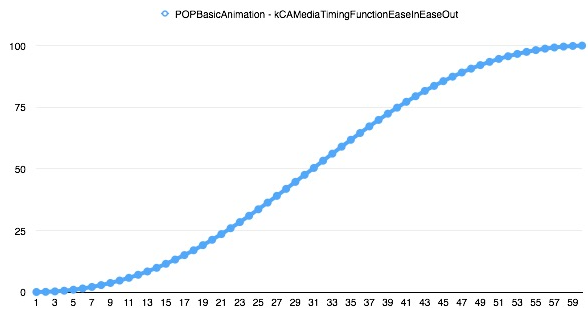
POPSpringAnimation
POPSpringAnimation也许是大多数人使用POP的理由 其提供一个类似弹簧一般的动画效果(使用后 APP立马就活泼起来了 有木有?!)
代码示例23
POPSpringAnimation *anSpring = [POPSpringAnimation animationWithPropertyNamed:kPOPLayerPositionX]; anSpring.toValue = @(self.square.center.y+300); anSpring.beginTime = CACurrentMediaTime() + 1.0f; anSpring.springBounciness = 10.0f; [self.square pop_addAnimation:anSpring forKey:@"position"];
其动画效果如下

POPSpringAnimation可配置的属性与默认值为
springBounciness:4.0 //[0-20] 弹力 越大则震动幅度越大 springSpeed :12.0 //[0-20] 速度 越大则动画结束越快 dynamicsTension :0 //拉力 接下来这三个都跟物理力学模拟相关 数值调整起来也很费时 没事不建议使用哈 dynamicsFriction:0 //摩擦 同上 dynamicsMass :0 //质量 同上
注意:POPSpringAnimation是没有duration字段的 其动画持续时间由以上几个参数决定
其时间函数如下

POPDecayAnimation
POPDecayAnimation提供一个过阻尼效果(其实Spring是一种欠阻尼效果) 可以实现类似UIScrollView的滑动衰减效果(是的 你可以靠它来自己实现一个UIScrollView)
代码示例3
POPDecayAnimation *anDecay = [POPDecayAnimation animationWithPropertyNamed:kPOPLayerPositionX]; anDecay.velocity = @(600); anDecay.beginTime = CACurrentMediaTime() + 1.0f; [self.square pop_addAnimation:anDecay forKey:@"position"];
其动画效果如下
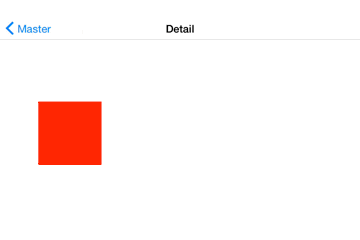
注意:这里对POPDecayAnimation设置toValue是没有意义的 会被忽略(因为目的状态是动态计算得到的)
POPDecayAnimation可配置的属性与默认值为
deceleration:0.998 //衰减系数(越小则衰减得越快)
注意:POPDecayAnimation也是没有duration字段的 其动画持续时间由velocity与deceleration决定
其时间函数如下
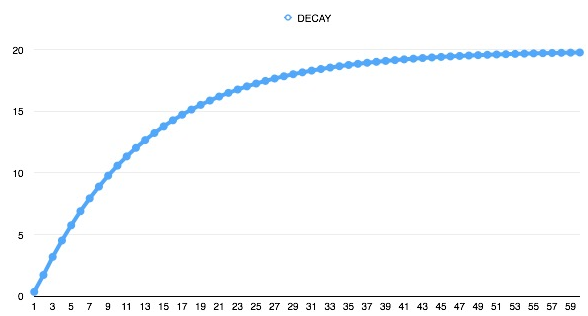
接下来我们看一下POP默认支持哪些属性的动画 打开POPAnimatablePropery.h可以看到如下定义(这些是到目前为止 所支持的属性 随着版本的更新 还在不断的新增中 :)
/** Common CALayer property names. */ extern NSString * const kPOPLayerBackgroundColor; extern NSString * const kPOPLayerBounds; extern NSString * const kPOPLayerCornerRadius; extern NSString * const kPOPLayerBorderWidth; extern NSString * const kPOPLayerBorderColor; extern NSString * const kPOPLayerOpacity; extern NSString * const kPOPLayerPosition; extern NSString * const kPOPLayerPositionX; extern NSString * const kPOPLayerPositionY; extern NSString * const kPOPLayerRotation; extern NSString * const kPOPLayerRotationX; extern NSString * const kPOPLayerRotationY; extern NSString * const kPOPLayerScaleX; extern NSString * const kPOPLayerScaleXY; extern NSString * const kPOPLayerScaleY; extern NSString * const kPOPLayerSize; extern NSString * const kPOPLayerSubscaleXY; extern NSString * const kPOPLayerSubtranslationX; extern NSString * const kPOPLayerSubtranslationXY; extern NSString * const kPOPLayerSubtranslationY; extern NSString * const kPOPLayerSubtranslationZ; extern NSString * const kPOPLayerTranslationX; extern NSString * const kPOPLayerTranslationXY; extern NSString * const kPOPLayerTranslationY; extern NSString * const kPOPLayerTranslationZ; extern NSString * const kPOPLayerZPosition; extern NSString * const kPOPLayerShadowColor; extern NSString * const kPOPLayerShadowOffset; extern NSString * const kPOPLayerShadowOpacity; extern NSString * const kPOPLayerShadowRadius; /** Common CAShapeLayer property names. */ extern NSString * const kPOPShapeLayerStrokeStart; extern NSString * const kPOPShapeLayerStrokeEnd; extern NSString * const kPOPShapeLayerStrokeColor; extern NSString * const kPOPShapeLayerFillColor; /** Common NSLayoutConstraint property names. */ extern NSString * const kPOPLayoutConstraintConstant; #if TARGET_OS_IPHONE /** Common UIView property names. */ extern NSString * const kPOPViewAlpha; extern NSString * const kPOPViewBackgroundColor; extern NSString * const kPOPViewBounds; extern NSString * const kPOPViewCenter; extern NSString * const kPOPViewFrame; extern NSString * const kPOPViewScaleX; extern NSString * const kPOPViewScaleXY; extern NSString * const kPOPViewScaleY; extern NSString * const kPOPViewSize; extern NSString * const kPOPViewTintColor; /** Common UIScrollView property names. */ extern NSString * const kPOPScrollViewContentOffset; extern NSString * const kPOPScrollViewContentSize; extern NSString * const kPOPScrollViewZoomScale; extern NSString * const kPOPScrollViewContentInset; /** Common UITableView property names. */ extern NSString * const kPOPTableViewContentOffset; extern NSString * const kPOPTableViewContentSize; /** Common UICollectionView property names. */ extern NSString * const kPOPCollectionViewContentOffset; extern NSString * const kPOPCollectionViewContentSize; /** Common UINavigationBar property names. */ extern NSString * const kPOPNavigationBarBarTintColor; /** Common UIToolbar property names. */ extern NSString * const kPOPToolbarBarTintColor; /** Common UITabBar property names. */ extern NSString * const kPOPTabBarBarTintColor; /** Common UILabel property names. */ extern NSString * const kPOPLabelTextColor;
作为刚接触POP的一些同学来说 如果在上面看到你希望的某些属性的话 你可以像 官方代码示例 一样指定这个属性即可开始动画了
但是如果你想要的某些属性不在之上呢 这时候自定义属性POPAnimatableProperty就排上用场了
自定义属性
POP默认支持的三种动画都继承自 POPPropertyAnimation POPPropertyAnimation中定义了一个叫property的属性( 之前没有用到它是因为POP根据不同的默认动画属性帮你生成了默认的property) 而这个property则是用来驱动POP的动画效果中的重要一环
代码示例4
POPAnimatableProperty *prop = [POPAnimatableProperty propertyWithName:@"prop" initializer:^(POPMutableAnimatableProperty *prop) { // read value prop.readBlock = ^(id obj, CGFloat values[]) { }; // write value prop.writeBlock = ^(id obj, const CGFloat values[]) { }; // dynamics threshold prop.threshold = 0.01; }]; 其组成就是一个readBlock一个writeBlock和一个threashold
-
readBlock告诉POP当前的属性值
-
writeBlock中修改变化后的属性值
-
threashold决定了动画变化间隔的阈值 值越大writeBlock的调用次数越少
POPAnimatableProperty其实是POP中一个比较重要的东西 像上面提到的POP自带的动画属性 查看源代码可以看到也只是POP自动帮你设置好了POPAnimatableProperty而已 其作用就是当动画的某个时间片被触发时 告诉系统如何根据当前时间片做出变化
还是以一个实际的例子来说明如何使用自定义属性 比如我们要实现一个像系统的时钟APP里秒表计时的一个效果
POPAnimatableProperty *prop = [POPAnimatableProperty propertyWithName:@"countdown" initializer:^(POPMutableAnimatableProperty *prop) { prop.writeBlock = ^(id obj, const CGFloat values[]) { UILabel *lable = (UILabel*)obj; label.text = [NSString stringWithFormat:@"d:d:d",(int)values[0]/60,(int)values[0]%60,(int)(values[0]*100)0]; }; // prop.threshold = 0.01f; }]; POPBasicAnimation *anBasic = [POPBasicAnimation linearAnimation]; //秒表当然必须是线性的时间函数 anBasic.property = prop; //自定义属性 anBasic.fromValue = @(0); //从0开始 anBasic.toValue = @(3*60); //180秒 anBasic.duration = 3*60; //持续3分钟 anBasic.beginTime = CACurrentMediaTime() + 1.0f; //延迟1秒开始 [label pop_addAnimation:anBasic forKey:@"countdown"]; 其动画效果如下

有没有从中得到一些启发呢? POP可以做的事情可远比Core Animation要多(注意这里我们使用了beginTime这个属性来设置动画的延迟施放) 例如音乐播放时那种淡入淡出的效果等等也可以用POP来实现
小结
其实只需要熟练掌握POP自带的三种动画 即可完成大部分的动画效果 如果实在是无法满足你的需求的话 自定义动画也基本可以满足你的要求 可以说POP化繁为简的出现 极大的方便了我们这些苦逼的coder
当然 就像我说的 POP不仅仅是一个动画引擎 相信经过我最后一个例子 大家可以得到一点启事 POP能做的事情还不少 :)











![[HBLOG]公众号](https://www.liuhaihua.cn/img/qrcode_gzh.jpg)

